Typically, my days go by unnoticed and in a routinely fashion, that is, I cannot put any sort of definite markers to make the day memorable or stick out in my recollections. However, last Wednesday was different. I seemed to live by a theme: Latin American food in Los Angeles. I fasted through lunch to save room for my adventures through the Boyle Heights Mexican food scene and then later for a nostalgic, Argentine experience in Hollywood.
Tacos de Camarones at Mariscos Jalisco
The adventure started at Mariscos Jalisco, an unsuspecting food truck parked on East Olympic Boulevard in the neighbourhood of Boyle Heights. Among some of the first students to arrive at the spot, I witnessed locals casually line up at the truck to place their orders. It all seemed casual and habitual compared to the eager excitement I was experiencing after having read Jonathan Gold’s review, stating that Raul Ortega is “…a rock star among taco chefs” (Gold 2012). I was ready to have a rock star experience.
After ordering two tacos de camarones and a mandarín Jarritos, I the show was ready to begin. I sat casually by the outside of the building and took my first few bites of the incredibly delicious tacos in the company of two young locals of the area. We chatted for a bit, and they told me that one of them was a regular customer that wanted to bring his buddy by to experience this gastronomic anomaly of a food truck. The regular customer said that he could never order anything else on the menu except for the tacos de camarones because they were “just too fucking good to pass up.” I can’t say I disagree.
The rock star himself, Raul Ortega, came by to talk with the class about his experience with the taco truck. He shared the story of the conception of his taco truck, which took place 17 years ago. In the infancy of his food truck endeavors, Ortega “…attributes his original success to the community” of Boyle Heights, which included many immigrants from his home region of Jalisco, México (Portnoy, 2016, p.73). Although national attention like Gold’s review brought a wider customer base from all around the city, it is clear that Ortega’s baby grew out of and provides for the community in which it was conceived.
This is an especially important aspect of Mariscos Jalisco as Boyle Heights has become the battlefield for wars against gentrification. Organizations like Gentify take an inside approach to developing underserved communities like Boyle Heights by “find[ing] Latino entrepreneurs already operating in a neighborhood, and help them make their businesses more successful and popular” (Delgadillo 2016). Ortega and Mariscos Jalisco is a perfect example of a community grown and operated business that contributes to the betterment of the community.
El Mercadito’s Oaxacan Delicacies
The next stop on my Latino food day was at El Mercadito, a two story building in Boyle Heights that sells as many Mexican foods and relics as you could possibly imagine. According the the Los Angeles Conservancy, the building was originally home to a multiethnic market, including Mexican, Japanese, and Italian products (“El Mercado”). However, the building has evolved over time to reflect the changing demographic in the area, which is mainly Mexican.
My focus was on one particular type of regional Mexican cuisine at El Mercadito: Oaxacan. As Sarah Portnoy points out in her book Food, Health, and Culture in Latino Los Angeles, “Oaxacan cuisine is one of the best examples of a regional cuisine that started to appear throughout the city [Los Angeles] as more Oaxacans immigrated to Southern California” (30). I could see that this held true in El Mercadito, where large containers of a variety of different moles lined the aisles. The friendly vendors offered samples of the moles, and they even recommended certain varieties according to the flavors that I was looking for. I am a hater of chocolate, and thus not typically a huge fan of mole, but these ladies made sure that I found one that fit my flavor profile.
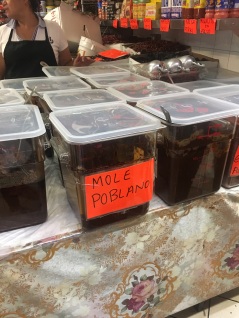
There was one experience that I really wanted to have related to Oaxacan cuisine: chapulines. I bought a container of them from one of the vendors to try with my other classmates. I delighted in the disgusted reactions of some of my peers as well as the crunchy, salty, and even sour experience of eating my first grasshopper. Although this was a fun experience, I came to learn that chapulines are not a joke to the native population in Oaxaca. The low-cost source of protein is a “a gift from God” for the impoverished, rural inhabitants of the region who not only feed their families with them but also have more economic opportunity through the selling and exportation of the chapulines (Cohen et al. 2009).
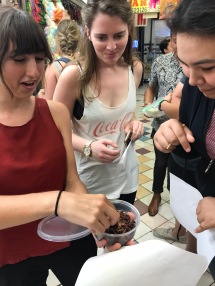
Kernel of Truth (and passion)
My tour of Boyle Heights ended at a run-down building with a sign that read “Supe’s Tortilleria” not far from El Mercadito. As soon as I stepped into the home of Kernel of Truth, though, I could see that the building was very much alive. We were met by a frantic sounding Ricardo Ortega, co-founder of the non-gmo, organic tortilla business. He has reason to sound frantic because he works 15 hours a day to see his passion for tortillas come to fruition. Ortega shared his goal to provide “real” tortillas to the greater Los Angeles community, often referring to the poor quality tortillas that we generally see in the grocery store. Just like Mariscos Jalisco, Kernel of Truth is part of the ‘gentefication’ process of the Boyle Heights area, with their ultimate goal to provide a low-cost, healthy tortilla option to their own community.
Ortega stepped us through the factory so that we could see the various stages of tortilla production. They start with huge vats of corn that are soaked in a limewater solution, which must remain there at a certain temperature and stirred constantly for many hours. This corn is then ground into a flour and is used to make masa, the dough from which tortillas are made. Ortega passed around two lumps of masa, one from white corn and the other from yellow corn, for us to feel and smell the fresh, warm dough. The masa then goes through a machine that punches out flat circles of masa and cooks them to perfection. We collected tortillas at the end of the conveyor belt to try on the spot and take home to witness the difference of a socially, environmentally, and health-conscious tortilla made with a lot of love and passion.
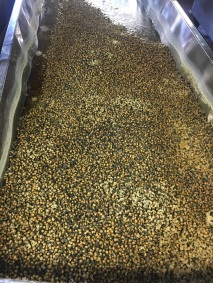
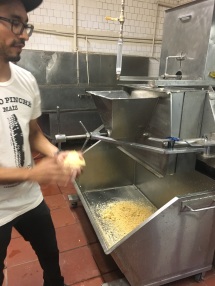
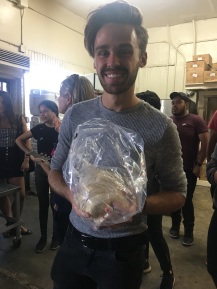
Nostalgia for Argentina
Although Kernel of Truth was the last stop on my Boyle Heights adventure, I still had one more outing to go for the day. My friends and I from the USC study abroad program in Buenos Aires, Argentina packed into my car and headed to Catalina’s Market in Hollywood to relive our porteño way of life. Before this outing, though, I had done some research on supermercados argentinos in Los Angeles, prompted by a dire lack of yerba mate in my life. I arrived at the nicely designed website of Catalina’s Market, which included an “About Us” section that explained roots of the multi-generational run business. Founded in 1967 by Catalina Corrado, Felipe Corrado Sr. and their son Felipe Corrado Jr. in Pasadena, they established their much larger current location in 1971 to expand their products from just delis and meats to products from the Caribbean, Spain, Central and South America. The Corrado family came to Los Angeles with the larger waves of Argentine immigrants to the US, mostly college-educated people searching for more economic opportunity outside of the Peronist-governed Argentina (Dapia 2013).
Upon arrival, I was slightly surprised by the exterior of the building. The website brags that “Catalina’s Market has catered to a niche clientele seeking quality products not found in every grocery store” (“About Us”). This line, especially the phrase “niche clientele,” made it sound like an upscale specialty store, but that was not what I found on the Koreatown-Hollywood border. The building looked like any other local, Latino supermercado, except for a sign in the window advertising their award-winning empanadas. I could sense the confusion and slight disappointment of my friends in the car.
I genuinely thought I had failed my friends until we walked into the store and saw that the website followed through with all of its promises. Half of an aisle was dedicated to various brands of yerba (including my favorite, Playadito), the other half lined with bottles of Argentine and other South American wine (again, including my favorite, Trumpeter Malbec from Mendoza, Argentina). My friends revelled in the variety of alfajores and the nostalgia of seeing Quilmes beer once again. We were like kids in a candy shop.
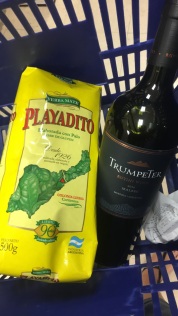
After the initial excitement of all of the available products (which really do go beyond the scope of just Argentine goods), I shopped for all of the ingredients for the empanada filling I was going to make that night. The man at the checkout counter, who I later learned was Felipe Corrado Jr. himself, helped me find all of the ingredients that I needed for my relleno. We spoke in Spanish, and he immediately recognized the porteño accent I had acquired during my time in Buenos Aires. I regretfully said that no, I am not a true porteña, but he was delighted to see my excitement for the products that his business offered.
By the time we were done shopping, we had worked up an appetite. Luckily for us, Cafe Catalina is conveniently located inside the grocery store, offering freshly prepared, Argentine staples, like savory empanadas and milanesa sandwiches. We placed our order in our best Argentine Spanish, and the man behind the counter inquired about our backgrounds (it was quite obvious that we are not from Argentina, given that we visibly represent black, white, Mexican, and Egyptian ethnicities). He revealed to us that he is an immigrant from the Salta region of Argentina, a northern area known across the country for having the best empanadas. Given this information, I had no other choice but to order them.
After devouring the empanadas and reminiscing on the car ride home with my friends to our favorite boliche tunes (songs played in the discotecas), I went home to begin the timely and delicate process of making my Argentine friend’s grandma’s recipe for empanada filling. During this process (and since then), I have considered what parts of my experiences that day were “authentic.” As José Johnston and Shyon Baumann argue, “…the categories that are used to discuss culinary authenticity are geographic specificity, ethnic connections, a personal connection to an individual creator or to a family tradition, and a dish’s simplicity and its historical roots” (Portnoy, 2015, p.84). According to these criterion of authenticity, I can deem my adventures as a truly authentic experience. The food and products had their own regional and ethnic specificities, and I even got to know more about some of the family ties and connections that the various players had with the food and products they offered. The dynamic and socially constructed definition of authenticity makes every experience truly authentic, as long as it is true to its time and place as Mariscos Jalisco, El Mercadito, Kernel of Truth, and Catalina’s Market are.

References
“About Catalina’s .” Catalina’s Market, catalinasmarket.com/about.php.
Cohen, Jeffrey H., et al. “Chapulines and Food Choices in Rural Oaxaca.” Gastronomica, vol. 9, no. 1, 2009, pp. 61–65., doi:10.1525/gfc.2009.9.1.61.
Dapia, Silvia. “Argentine Americans.” Multicultural America: A Multimedia Encyclopedia, Edited by Carlos E Cortés, 2013, pp. 272–274., doi:10.4135/9781452276274.n89.
Delgadillo, Natalie. “Defining ‘Gentefication’ in Latino Neighborhoods.” CityLab, 28 Sept. 2016, www.citylab.com/equity/2016/08/defining-gentefication-in-latino-neighborhoods/495923/.
“El Mercado .” 1900s | Los Angeles Conservancy, Los Angeles Conservancy, http://www.laconservancy.org/locations/el-mercado.
Gold, Jonathan. “Taco Tuesday: Tacos Dorados De Camarones.” Los Angeles Times, 21 Aug. 2012, articles.latimes.com/2012/aug/21/news/la-dd-crunchy-shrimp-tacos-at-east-los-angeles-taco-truck-mariscos-jalisco-20120820.
Portnoy, Sarah. “Authenticity of Cuisines.” The SAGE Encyclopedia of Food Issues, 2015, pp. 84–87., doi:10.4135/9781483346304.n35.
Portnoy, Sarah. Food, Health, and Culture in Latino Los Angeles. Rowman & Littlefield Publishers, 2016. ProQuest Ebook Central, https://ebookcentral.proquest.com/lib/socal/detail.action?docID=4756736.